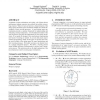Free Online Productivity Tools
i2Speak
i2Symbol
i2OCR
iTex2Img
iWeb2Print
iWeb2Shot
i2Type
iPdf2Split
iPdf2Merge
i2Bopomofo
i2Arabic
i2Style
i2Image
i2PDF
iLatex2Rtf
Sci2ools
CORR
2006
Springer
2006
Springer
Modeling Aspect Mechanisms: A Top-Down Approach
A plethora of aspect mechanisms exist today. All of these diverse mechanisms integrate concerns into artifacts that exhibit crosscutting structure. What we lack and need is a characterization of the design space that these aspect mechanisms inhabit and a model description of their weaving processes. A good design space representation provides a common framework for understanding and evaluating existing mechanisms. A well-understood model of the weaving process can guide the implementor of new aspect mechanisms. It can guide the designer when mechanisms implementing new kinds of weaving are needed. It can also help teach aspectoriented programming (AOP). In this paper we present and evaluate such a model of the design space for aspect mechanisms and aving processes. We model weaving, at an abstract level, as a concern integration process. We derive a weaving process model (WPM) top-down, differentiating a reactive from a nonreactive process. The model provides an in-depth explanation o...
Aspect Mechanisms | CORR 2006 | Design Space | Education | Model |
| Added | 11 Dec 2010 |
| Updated | 11 Dec 2010 |
| Type | Journal |
| Year | 2006 |
| Where | CORR |
| Authors | Sergei Kojarski, David H. Lorenz |
Comments (0)

